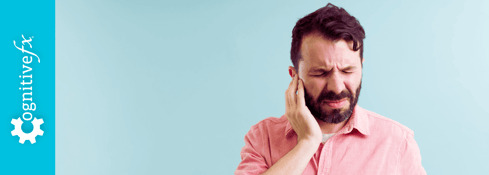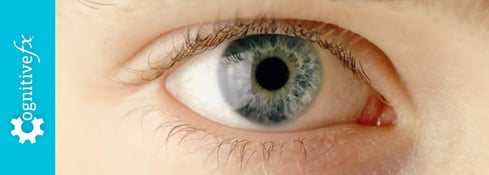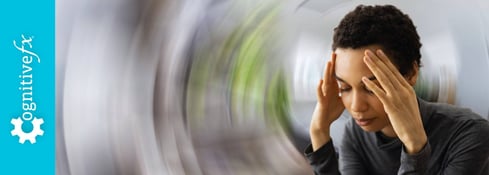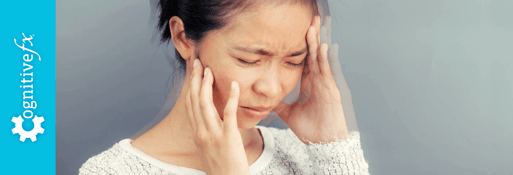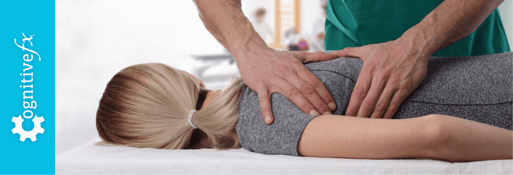Following concussions and traumatic brain injuries (TBIs), impaired vision and vision-related symptoms are common. Signs and common symptoms include blurred vision, light sensitivity, light-related headaches, eye movement issues, and more.
If you’ve experienced a head injury with accompanying visual issues, special post-concussion glasses may provide some symptom relief or help speed up recovery.
However, different types of post-concussion syndrome glasses are not interchangeable for all situations. It’s vital to match the appropriate glasses to your medical history and symptoms — and also to be aware that, when used incorrectly, specialty glasses can actually cause more problems.
We would know: Many of the patients who visit our post-concussion syndrome treatment clinic, Cognitive FX, suffer from visual or vestibular issues of some kind.
Sometimes, we include post-concussion syndrome glasses in their treatment plan, but they’re not always necessary. We take a therapy-first approach to address the underlying issues (and it works — the average improvement in our patients after one week of treatment is 75%).
So how do you know if glasses will help you — or if you even need them? In this article, we cover everything patients need to know about the most common types of glasses used to ease symptoms and aid rehabilitation for post-concussion syndrome, including:
But before we dive into how specific glasses fit into post-concussion recovery, the best place to begin is with an overview of how glasses are used as a tool for concussion recovery and what current scientific research says about them.
At Cognitive FX, we specialize in treating patients with lasting post-concussion symptoms. 95% of our patients experience statistically verified restoration of brain function after treatment. To learn if our treatment is right for you, schedule a consultation.
Note: Any data relating to brain function mentioned in this post is from our first generation fNCI scans. Gen 1 scans compared activation in various regions of the brain with a control database of healthy brains. Our clinic is now rolling out second-generation fNCI which looks both at the activation of individual brain regions and at the connections between brain regions. Results are interpreted and reported differently for Gen 2 than for Gen 1; reports will not look the same if you come into the clinic for treatment.
What Are Post-Concussion Glasses (And Do They Work)?
Post-concussion glasses are therapeutic glasses designed to relieve symptoms or help rehabilitate vision following a concussion or TBI.
The scientific reason that visual involvement in concussions is common is because over half of the brain’s pathways are dedicated to vision and eye movement control.
According to the best research, over 60% of brain injury survivors may suffer from convergence insufficiency (an eye disorder where your eyes don’t move at the same time) following a concussion — and the numbers are similar for accommodative weakness, another motor control issue that makes it difficult to control the focusing muscles of the eyes.
While statistics aren’t available for every type of visual dysfunction, neurologists and neurology researchers agree that vision-related issues in general are incredibly common after mild traumatic brain injuries (mTBI).
Because the visual system can be affected in so many different ways depending on the nature of your injury, there is a wide range of visual problems that may present following an mTBI, including:
- Photophobia (light sensitivity).
- Blurred vision.
- Poor depth perception.
- Reduced visual acuity.
- Problems with pupillary function.
- Eye movement abnormalities.
- Visual processing problems.
Post-concussion glasses work to help relieve these issues or other post-concussion symptoms by either:
- Changing how light reaches your eye (such as by blocking certain portions of the visible light spectrum), or
- Requiring your eyes or brain to work differently to process visual imagery, effectively retraining your ocular system.
Or both at the same time.
Post-concussion glasses have shown some promising early results in peer-reviewed research, but overall, the scientific literature is currently lacking in strong evidence or proven efficacy for many applications of these glasses.
At Cognitive FX, we’ve found that when used correctly for the appropriate matching symptoms, and as one part of a well-rounded concussion treatment regimen, they can work well for many post-concussion patients.
Used correctly, and in conjunction with appropriate therapy, there’s minimal risk associated with trying most types of post-concussion glasses. But there’s no circumstance where post-concussion glasses are all that’s needed to recover from post-concussion syndrome. They’re only one possible tool of many and can never replace a comprehensive plan to rehabilitate your brain.
It’s great when patients experience some relief from wearing specialty glasses. But it’s problematic if they end up either wearing them all the time without taking intentional breaks (a bad idea) or using them indefinitely as the only way to manage symptoms (a very bad idea).
This usually occurs when the glasses are prescribed by an optometrist without a real treatment plan to accompany them, or when patients purchase glasses on their own without consulting concussion recovery specialists.
For an in-depth look at vision recovery after a concussion — including more information on visual symptoms, other tools besides post-concussion glasses, and patient recovery stories — read our article on TBI-related vision problems and vision therapy treatment options.
Color-Tinted Glasses
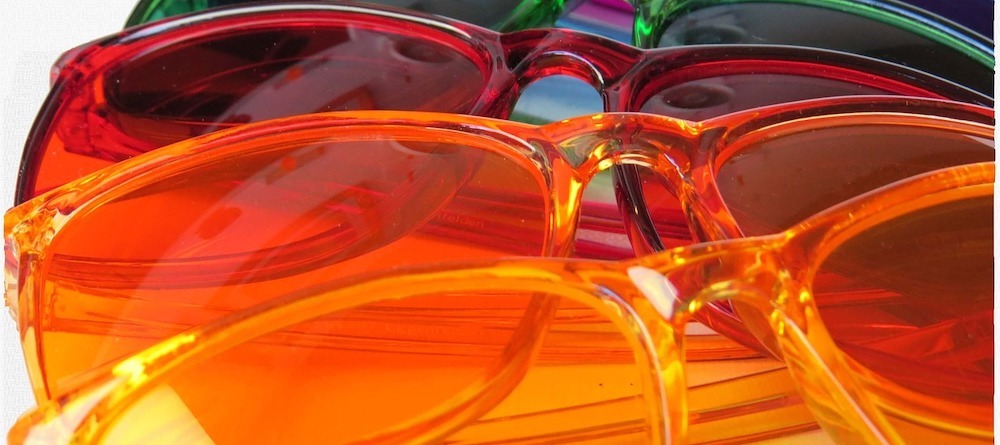
Color-tinted glasses are exactly what they sound like: glasses with tinted lenses that only allow specific wavelengths of visible light through. They may look similar to trendy glasses, but there’s another reason to consider colored lenses besides making a fashion statement.
Different portions of the visible light spectrum can have different effects on your eyes and brain, for example:
- Blue light is shown in some research to increase alertness and cognition, as well as increasing patients’ brain oxygenation.
- Red light may alter the function of the autonomic nervous system, promoting relaxation.
- Yellow light appears to activate the left prefrontal cortex, which could support visual pattern recognition.
- Early evidence suggests green light doesn’t trigger photophobic migraines and may help reduce headache frequency, which might also translate to light-sensitive headaches experienced by TBI patients.
And those findings may only be scratching the surface. The relationship between light and brain function is complicated, and scientists haven’t mapped it out fully. But what’s clear is that different colors of light can affect hormone production, brain area activation, and other aspects of brain function in a variety of ways.
When it comes to color-tinted lenses for head injury symptoms, there are currently only a few direct studies. One promising study found that when participants with TBI-related photophobia symptoms self-selected color-tinted lenses from a variety of different colors and wore them, 85% of them experienced relief from light sensitivity. (And practically speaking, one advantage is that unlike dark sunglasses, color-tinted lenses still allow you to see indoors.)
Another smaller study found that post-concussion patients had measurably better visual performance when wearing colored glasses.
Based on our observations of patients at Cognitive FX, the most interesting property of colored glasses is that, unlike most of the other post-concussion glasses available, they often seem to have a broader effect.
In other words, whereas most glasses have a very narrow application for specific symptoms, patients may experience at least temporary relief from a variety of symptoms by finding the tint that best suits their current brain function.
Color-tinted glasses are among the most versatile glasses for post-concussion syndrome. They’re also relatively inexpensive and safe to try out, which makes it easy to experiment with different tints to discover what works for your symptoms. (We use these at the clinic.)
If you shop around, you can find multi-packs that have different colors to try for a reasonable price (around $10 per pair). Along with the colors listed above (blue, red, yellow, and green), some patients experience good results from orange lenses (a combination of red and yellow), purple lenses (a combination of blue and red), or other colors.
That said, make sure you don’t wear them all day every day, and definitely don’t rely on them as a standalone treatment for recovering from a brain injury.
Prism Glasses
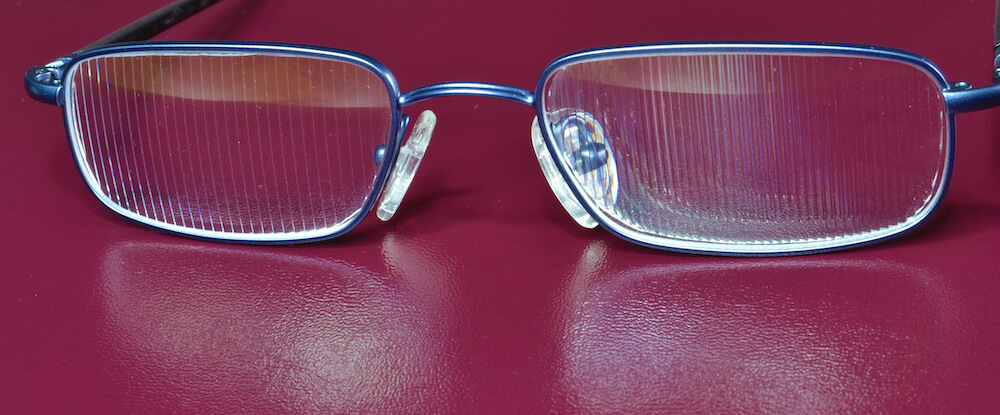
Prism glasses are special glasses with a transparent prism in the middle of each lens that refracts light. Along with treating some visual symptoms of head injuries, prism glasses are sometimes used in optometry to treat astigmatism (blurry or distorted vision caused by irregularities in your eyes’ lenses).
The idea behind prism glasses is that if your eyes are unable to focus on an object effectively, the prism may help bring them back into balance and train your eyes to focus differently.
To focus properly, your eyes must converge (meet at a specific visual point in space) according to the distance and position of the focus object. Frequently, post-concussion patients experience motor control dysfunction that results in convergence problems — in effect, the brain is giving incorrect orders to the eyes, and the outcome is being unable to focus correctly.
Early studies show promising results for prism glasses following head injury, but as yet, there’s no evidence they’re helpful for long-term use or addressing the underlying (brain-based) causes of post-concussion visual problems.
In our experience working with patients at Cognitive FX, we’ve found that prism glasses can sometimes be effective early in the recovery process for providing temporary relief in patients who have converge insufficiency, visual focus problems, or related motor control dysfunction.
We don’t use them as a first-line tool in our approach to vision therapy, but we sometimes incorporate them when patients don’t respond to vision exercises or other techniques. It appears that by helping the brain focus the eyes differently, prism glasses essentially can allow your eyes and brain to “rest,” which may help speed recovery and work in concert with other treatment methods for vision rehab.
In other cases, post-concussion patients have been prescribed prism glasses indefinitely by their providers, which we strongly disagree with. The concern here is that not only are the glasses insufficient to address the fundamental problems of post-concussion syndrome, but also that — when used all the time or indefinitely — they can actually lead to dependence on the prism lenses and worsening of visual symptoms.
Blue-Blocking Glasses
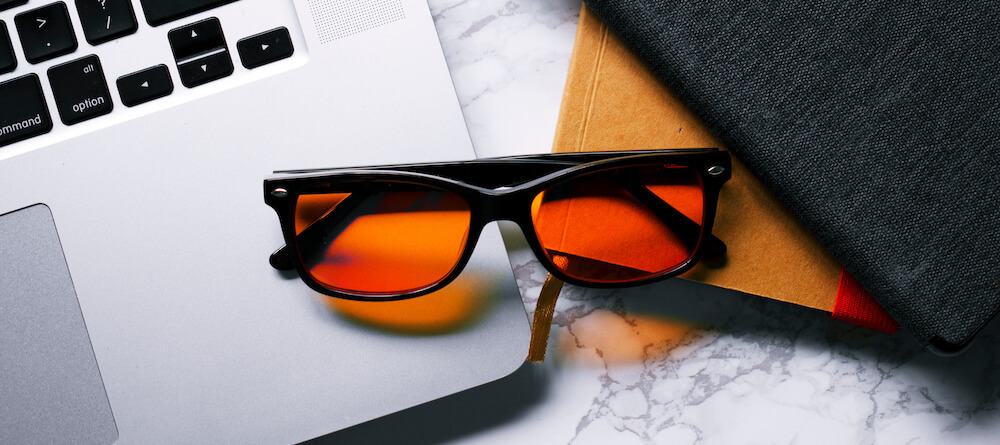
Blue light blocking glasses are a specific type of color-tinted glasses designed to prevent blue light wavelengths from entering your eyes. They’ve recently become popular among mainstream users for reducing eye strain at computers as well as increasing sleep quality.
Research suggests that because blue light emitted by digital LED screens is intense and different from natural light, it may contribute to eye fatigue and even result in long-term damage to eyes. We've found post-concussion patients often feel more comfortable blocking blue light when using screens, especially when ocular dysfunction is also present.
And as we covered in a previous section about color-tinted glasses, blue light exposure can increase brain activation, which isn’t always a good thing. Some people with post-concussion syndrome experience brain hyper-activation, which is like system overload for the brain, and blue light exposure can make it worse. If you’re feeling overstimulated or experiencing “brain fog,” blocking blue light with tinted glasses might help you feel better in the short term.
Evidence shows that artificial blue light at night can also prevent your body from making melatonin, the sleep hormone. Many times, post-concussion patients experience insomnia or poor sleep, in which case blue-blocking glasses can potentially aid the recovery process by increasing sleep quality.
Blue-blocking lenses are usually yellow, orange, amber, or red in color. All of these lens colors are effective for blocking blue light, but unlike other colored glasses, you’ve got to be a little more selective when making a purchase — it’s best to go with a brand that’s sold for this specific purpose or rated to block light wavelengths in the 400 to 500 nanometer (nM) range.
In general, effective blue-blocking glasses are relatively dark (barely tinted “computer glasses” that have no real visible lens color aren’t effective blue blockers).
Binasal Occlusion Glasses
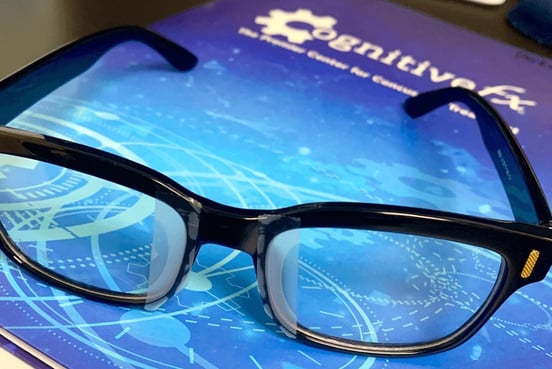
Binasal occlusion glasses are glasses that block (occlude) part of the wearer’s field of vision to help train the visual system to focus differently.
They work on a similar principle to prism glasses, but unlike prism glasses (which mainly address convergence insufficiency), binasal occlusion glasses are more useful for overconvergence.
To visualize overconvergence, imagine that you’re trying to focus on an object, but the line of sight of each eye is meeting (converging) at a point that’s too near relative to the location of the object, which can result in eyestrain, eye pain, headaches, and distorted vision.
Binasal occlusion glasses do result in some temporary symptom relief and related improvements for people with overconvergence following mild TBIs — but as with other types of post-concussion glasses, there’s no long-term evidence as to their efficacy, and they aren’t a substitute for a comprehensive treatment plan.
Most of the time, applying a narrow piece of opaque or translucent tape to each lens near the bridge of any pair of glasses can be an inexpensive and effective way to create binasal occlusion glasses, but it’s not a good idea unless you know what you’re doing.
Don’t self-diagnose overconvergence or create your own binasal occlusion glasses. Instead, work with a vision therapist who can make appropriate recommendations for your specific eye symptoms.
Pinhole Glasses
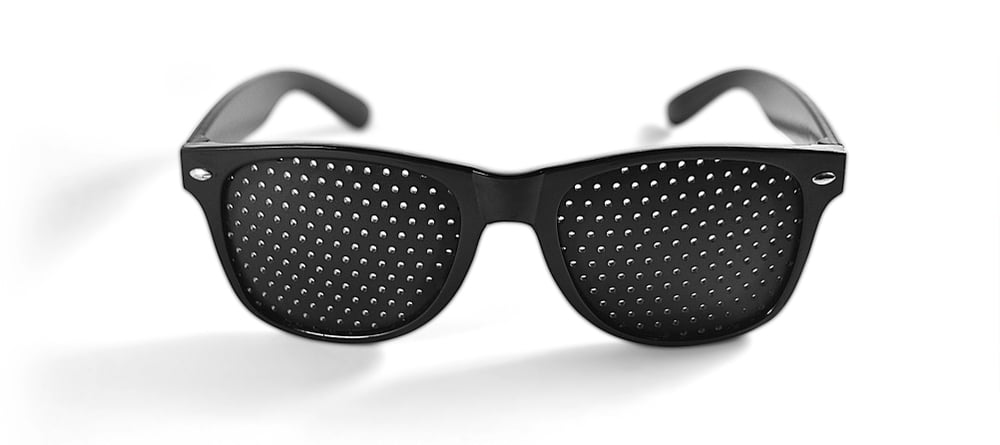
Pinhole glasses are special glasses with tiny, perforated holes that help reduce the amount of light and visual information entering your retina. They’re mainly used for reducing eye strain and as an adjunct during vision therapy exercises when patients are feeling overwhelmed.
The concept behind pinhole glasses for post-concussion syndrome is that full exposure to light rays — and the requirement for your brain to organize all that information into a coherent picture — can be overwhelming in people with brain injury symptoms. However, by reducing the light entering your eyes, you can give your brain a break and make its job easier.
We don’t recommend wearing pinhole glasses around day to day. Instead, use them selectively when needed to relax your eyes or deal with visual fatigue. Some people find them helpful for reading books.
Evidence demonstrates that pinhole glasses reduce visual quality while worn, so they’re not a good idea when working with equipment or playing sports, and you should never wear them while driving.
What to Do About Persistent Concussion Symptoms Aside From Wearing Glasses
.jpg?width=998&name=shutterstock_1444224863%20(1).jpg)
Color-tinted glasses, blue-blocking glasses, and pinhole glasses can all help with a relatively broad range of post-concussion symptoms, while prism glasses and binasal occlusion glasses are more specific and aren’t suitable for use by all post-concussion patients.
What all these glasses have in common, however, is that none of them are useful as a standalone approach for concussion recovery, and overreliance on them tends to set patients back in the long run.
Post-concussion syndrome can linger for years, and many well-meaning healthcare providers don’t realize that the “rest and darkness” prescription isn’t sufficient to ensure long-term healing. More often than not, unless you undertake a solid recovery plan, you will continue to experience symptoms that impact your quality of life indefinitely.
While concussion symptoms vary from patient to patient, problems with neurovascular coupling — in other words, a mismatch in supply and demand between neurons and the blood vessels that supply them with oxygen and fuel — are behind most issues associated with post-concussion syndrome.
At Cognitive FX, all patients receive a baseline fNCI scan at the beginning of treatment. (An fNCI is a special type of MRI that’s standardized for clinical use to measure blood flow in the brain and neurovascular coupling.) Then, our interdisciplinary concussion treatment team tailors our proven therapy regimen to your specific injury.
Most patients receive some mix of the following therapies during their intensive treatment period:
- Neuromuscular therapy.
- Occupational therapy.
- Cognitive therapy.
- Sensorimotor therapy.
- Neuro-integrative therapy.
- Psychotherapy.
- And more.
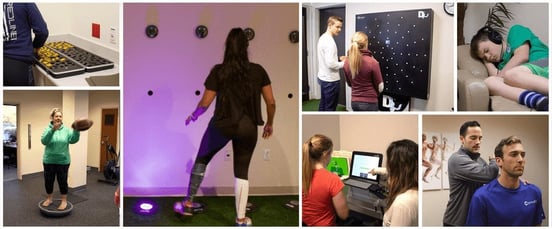
We then compare post-treatment fNCI results to the first scan to gauge your improvement, determine next steps, and prescribe a take-home plan to support continued recovery.
At Cognitive FX, 95% of our patients experience statistically verified restoration of brain function after treatment at our clinic. Their average one-week improvement on the scan is 75%; average one-week symptom improvement is 60%. To learn if you’re eligible for treatment, schedule a consultation with our team.

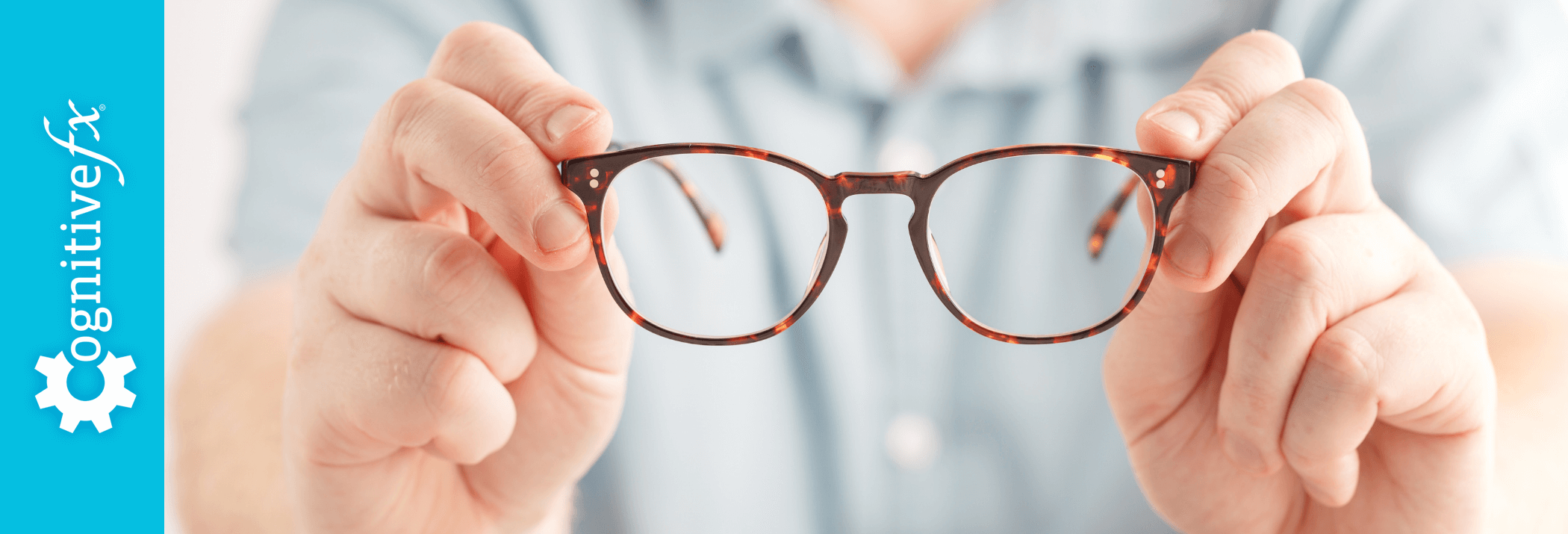





.jpg?width=998&name=shutterstock_1444224863%20(1).jpg)


